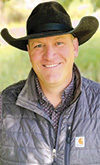As a risk management consultant, I get asked a lot of questions regarding Pasture, Rangeland and Forage (PRF). The PRF program is crop insurance for livestock producers. It uses the correlation between precipitation and forage growth as a measure of yield for the "crop" of rangeland grasses. Here are some questions that are asked more often than others.
Is PRF drought insurance?
While PRF is frequently referred to as drought insurance, it is not. That is because it is not based on drought conditions for your area. Many policies will pay out significant indemnities without the area ever entering any level of declared drought.
How does someone qualify for PRF?
PRF is really for the livestock producer, not the landowner. If you own livestock, you can qualify for PRF even if all your ground is leased. I really like this aspect because it keeps landowners and land-holding companies from using the program if they do not have any livestock as part of an agricultural enterprise. Another thing people often overlook is that hay ground can also qualify for PRF if it is being used to harvest forage for livestock – as long as it is not enrolled in a different crop insurance program.
How is PRF different from the disaster programs the FSA offers?
The biggest difference between PRF and the FSA programs is that PRF is an insurance product where the producer has a premium. The FSA disaster programs are more true aid programs where there is no input from the producer. If they or their area meet certain criteria and fill out the paperwork, they receive the funds. It is worth noting that the funds from most FSA offices often come well after the need arises. Indemnities from PRF are often available around 60 days after the interval ends.
How do the subsidies work? And how are they involved with the PRF program?
The subsidies are a percentage of the total premium. The subsidies vary based on coverage level. As your coverage level goes down, your amount of subsidy goes up.
- 90% coverage has a 51% subsidy
- 85% coverage has a 55% subsidy
- 80% coverage has a 55% subsidy
- 75% coverage has a 59% subsidy
- 70% coverage has a 59% subsidy
It is not very often that I see policies insured at under the 85% coverage level. They often don’t perform as well, meaning you would owe premium more often. A lot of producers feel like PRF is a government handout because of the subsidy. However, it is really to make risk management more affordable for producers, and it’s a way that the U.S. can protect food security in this country.
When would someone have to pay a premium?
There are several reasons that a producer may have to pay their premium. If average precipitation in their area (grids covered) during their covered intervals (two-month time frames) was at or above normal and there was not enough indemnity triggered to cover their full premium for that year, they would still owe part of their premium.
A more likely scenario is that precipitation in their covered grids and intervals was not significantly below normal. When precipitation is not low enough to trigger enough indemnity to pay a premium in full by the September due date, a producer may still owe part. Producers often find themselves in this situation when they have significant coverage in the later part of the year. That later coverage could pay the balance of the premium, and those funds are then returned to the producer.
It is important that ranchers understand there is a likelihood that they will owe premium at some point. It is highly unlikely that they will ever owe the full amount, but nonetheless, they should make sure they are comfortable with the premium amount if it comes to that. Premiums are dictated by the USDA Risk Management Agency (RMA), but there are ways to adjust coverage levels that can lessen the total premium owed.
When would someone see an indemnity?
Indemnities come as precipitation is below the 70-year average for covered grids, within covered intervals. The program is “self-funding,” which means that indemnities go toward the premium first. This avoids the need to come up with the funds when the policy begins. Once a policy's premium is paid in full, the remaining indemnities are then paid to the producer. This allows a lot of flexibility in managing dry conditions. Indemnities in general are based on the USDA declared county values for rangeland. They also depend on the percentage of coverage producers have placed in each interval.
When doing grid analysis for a ranch, why is it best to look at a 15- to 20-year window of estimates versus a shorter-term range?
This is an important part of looking into PRF. For a lot of policies, looking at the most recent seven to 10 years of data shows a skewed perspective of how PRF could have performed. For a large part of the U.S., conditions have been drier than normal. A shorter-term look would not consider wetter years prior. In addition, when average drought intervals are considered, a shorter-term window would barely capture one interval. By looking at longer-term data when considering PRF, ranchers can see a more realistic picture of how a policy could perform over time. It also enables producers to have more realistic expectations for the likelihood of owing a premium.





.jpg?t=1687979285&width=640)


